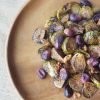
The Warm And Spicy History Of Cinnamon
By Sebrina Zerkus Smith | 7 Comments | Posted 10/16/2014
It’s the time of year when cinnamon takes center stage, pairing with the likes of allspice, nutmeg and cloves to give us the scents of the season. From October until the end of December, the air will be filled with the aroma of sumptuous treats, from mulled cider and pumpkin bread to Christmas cookies and wassail, each with a generous dose of cinnamon.
The warm and pungent taste of cinnamon has delighted us for centuries. But long before it delighted our taste buds, cinnamon was a highly prized and rare spice used for ceremonial and medicinal purposes. It was valued first for its scent, an aroma described as both divine and sensual.
By the 6th century B.C., it was one of the most prized spices. Cinnamon, along with frankincense and myrrh, is one of the oldest spices traded in the ancient world. Egyptians used it along with a similar spice, cassia, for embalming purposes. And it’s said that the Roman emperor Nero burned all the cinnamon he could find on the funeral pyre of his wife Poppaea Sabina in 65 A.D. Cinnamon is also mentioned in the Bible as an oil used for anointing. Cinnamon was regularly used in ointments and perfumes as well, regarded for its warm, earthy scent.
During the 13th century, Arab traders are believed to have brought cinnamon to Europe over arduous land routes, making the spice both costly and rare. So rare, in fact, that having cinnamon was considered a status symbol. But as the middle class grew and sought upward mobility, cinnamon was supposedly used by cooks as a way to preserve meat. This is a dubious claim, since cinnamon would have been very expensive, and salt curing and smoking were widely available. And although it’s true that cinnamon possesses antibacterial and anti-fungal properties, it’s more likely cinnamon was used sparingly to cover the taste of the rotting meat that was generally available to the masses.
Cinnamon comes from the bark of the Cinnamomon tree, an evergreen whose inner bark curls into the scroll-like quills that we call cinnamon sticks — and dunk into tea, coffee and hot chocolate. Ground cinnamon is made from the older bark on the lower part of the tree, and is stronger and more flavorful.
What most Americans call cinnamon is actually cassia, a related spice, which the FDA allows to be labeled “cinnamon.” It has a mild and slightly sweet flavor. And while it is not a “true” cinnamon, it’s mild flavor may actually be better for baking and drinking in beverages.
A true cinnamon, like Ceylon — spicy and hot — complements heartier, more savory dishes like curry or moussaka.
Today, cinnamon is widely available and prices can range from expensive, for a true Ceylon cinnamon from Sri Lanka to down right cheap, for a grocery store variety cassia cinnamon. But the flavor and aroma of cinnamon are everywhere. Mouthwash, toothpaste, candy, gum, as well as in baked goods and savory dishes. So while we can enjoy cinnamon in a way the ancients could not have dreamed of, real cinnamon can still be rare and elusive.
Just something to ponder as you sip your next chai latte.


 Contact us
Contact us



























